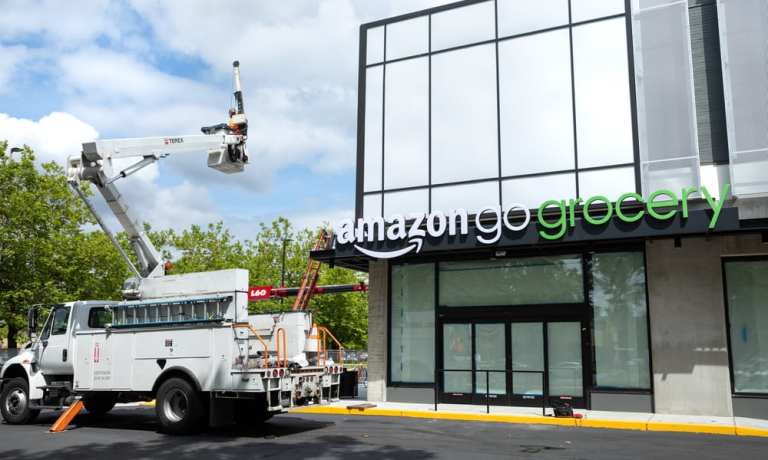
Amazon won the big headlines this week in the grocery world with its launch of the first brick-and-mortar Amazon Fresh grocery shopping location. It’s just the latest move in the growing war for dominance in the grocery world.
Here are some of this week’s big developments:
Amazon Fresh Gets Physical
Amazon opened its first of at least four Amazon Fresh physical stores, cutting the ribbon on a site in the Los Angeles neighborhood of Woodland Hills.
Although the site is only open by invitation right now, it will welcome the general public in a few weeks.
Three other Amazon Fresh locations — two in California and one in Greater Chicago — are currently in use as staging locations for Amazon grocery deliveries, but seem likely to eventually open to the public for in-store shopping.
Amazon’s online-grocery sales tripled year over year during Q2, prompting the eCommerce giant to increase grocery delivery capacity by more than 160 percent. The new brick-and-mortar Amazon Fresh store includes an online-order pick-up and return area for both groceries and Amazon.com purchases in general.
The store also features new smart shopping carts called “Dash Carts.” Consumers can log in via the Amazon app, then count on the cart’s cameras and sensors to keep track of what they’re purchasing. They can pay without having to stop at a cash register or self-service pay station.
All in, that’s a pretty slick feature set. It seems Amazon has once again raised the bar when it comes to omnichannel grocery shopping.
Good News And Bad News For Walmart’s Grocery Efforts
In a bit of surprising news, Walmart was the big winner of last week’s race to control consumer’s digital-grocery spend.
According to Coresight Research, Walmart surpassed Amazon as the most-shopped online grocer. Some 56 percent of online-grocery shoppers surveyed by Coresight in the past week said they had bought from Walmart, up from 52 percent in March. That just edged out Amazon, which 55 percent of online-grocery customers used.
Coresight also found that digital grocery relationship is only going to get more important over time. Some 36 of online-grocery shoppers surveyed said they didn’t expect their habits to change even after the pandemic ends.
But it was a bit of a good news/bad news week for Walmart. Other reports indicated that the chain is starting to lose some of its customer base to traditional grocery players.
“While Walmart is performing well, it is losing some share to traditional supermarkets,” said Scott Mushkin, an analyst at R5 Capital. “Consumers have rediscovered the traditional supermarket, and they like it.”
But analysts believe the market-share loss is only short-term. “It’s a big deal if the share loss is permanent, [but] we think it’s temporary,” Morgan Stanley analyst Simeon Gutman said.
The Great Grocery Slow Down?
U.S. grocery sales are slowing down as government-stimulus checks are depleted and unemployment benefits no longer include an extra $600 a week.
The Wall Street Journal reports that recent data from IRI point to a pullback in spending at the grocery — both online and in-store — after a long run of expansive growth in May, June and July.
The volume drops weren’t massive — low- to high-single-digit percentages in many food categories — but were notable after so a long period of growth.
With reduced aid coming from the government and unemployment rates that remain at historically high levels, consumers have been pulling back their spending in general — and now, that pullback is cutting into food purchases.
Grocery sellers have taken notice. “People perceive they’re spending more money on food despite eating out less. So, we’ll be thoughtful about the way we plan the rest of the year and react to changes in the trends we see from our shoppers,” Walmart U.S. CEO John Furner said recently on the retail giant’s conference call.
DoorDash Branches Out Into Grocery Delivery
App-based delivery firm DoorDash, heretofore known for restaurant deliveries, is adding groceries to its menu of options. That’s a direct challenge to grocery-delivery leader Instacart.
DoorDash recently started delivering from California’s Smart & Final grocery chain to users in the San Francisco, Los Angeles, Orange County, Sacramento, San Diego and Central Coast regions. The app also began offering deliveries in Chicago, Cincinnati, Milwaukee, Detroit and Indianapolis from the Meijer and Fresh Thyme Farmers Market chains.
DoorDash has confirmed that it’s also looking to expand its offering to chains like the Midwest’s Hy-Vee and New York’s Gristedes and D’Agostino, bringing grocery delivery to some 75 million Americans. It promises deliveries within an hour and on more than 10,000 standard grocery items, as well as ready-to-eat and refrigerated meals from numerous grocery chains.
But unlike Instacart, DoorDash is only getting involved in the delivery process itself. Stores will remain responsible for picking out and packing up orders. As it does with restaurants, DoorDash will merely provide the “dashers” to pick up and deliver prepared orders.
The bottom line: It seems like everyone in the grocery business is doing a bit of dashing these days as the industry pivots to meet consumers’ needs. Those needs are ever-changing — and increasingly controlled by a pandemic whose economic effects remain persistently uncertain.